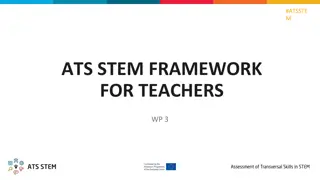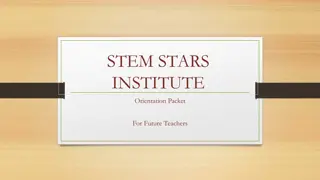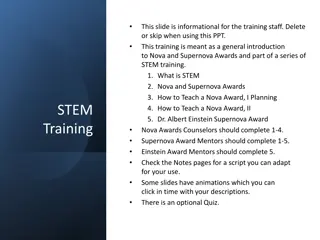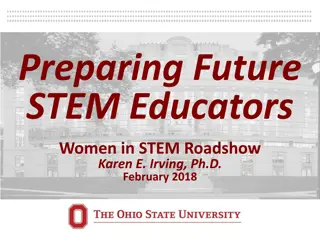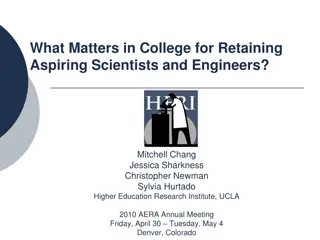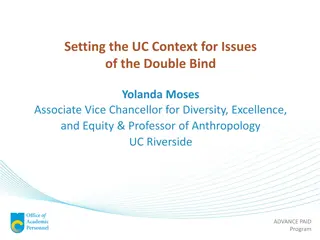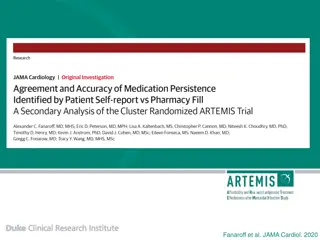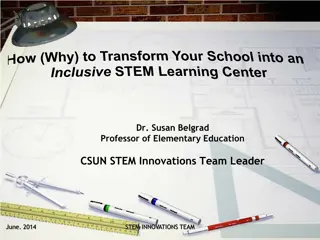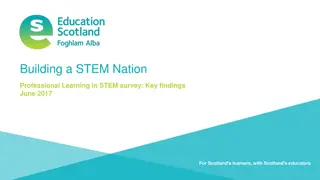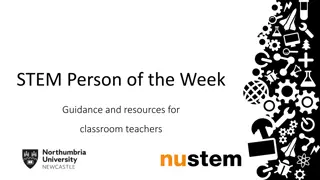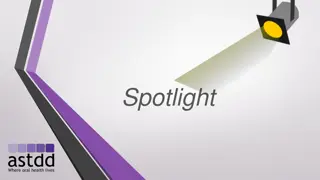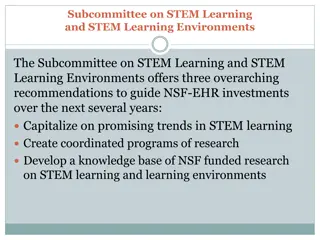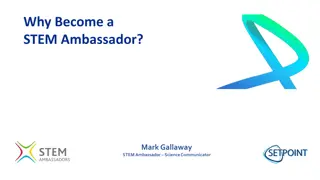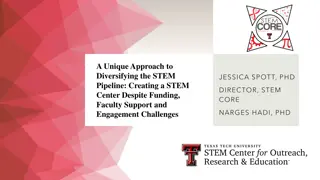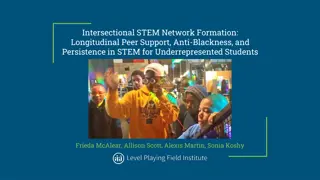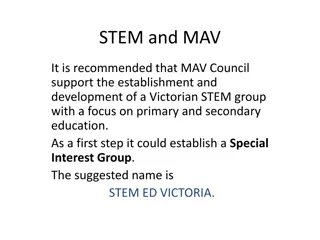Exploring Latinas/os in STEM: Factors Influencing Persistence
The study investigates the experiences of Latinas/os in STEM fields to understand the factors that contribute to their persistence. It highlights disparities in academic preparation, self-confidence, and aspirations compared to White students. Latinas/os face higher financial concerns, lower academic self-confidence, and reduced math and science course participation in high school. However, they show interest in NIH-sponsored programs, summer research initiatives, and aspire for advanced degrees and careers in healthcare. The research aims to address the underrepresentation of Latinas/os in STEM through longitudinal analysis.
Download Presentation

Please find below an Image/Link to download the presentation.
The content on the website is provided AS IS for your information and personal use only. It may not be sold, licensed, or shared on other websites without obtaining consent from the author. Download presentation by click this link. If you encounter any issues during the download, it is possible that the publisher has removed the file from their server.
E N D
Presentation Transcript
Latinas/os in STEM: A Longitudinal Look at the Experiences that Lead to Persistence American Association of Hispanics in Higher Education Sixth Annual National Conference San Antonio, TX March 4, 2011 Sylvia Hurtado, UCLA Gina A. Garcia, UCLA
Background National call to increase the participation of Latinas/os in STEM degrees and careers America COMPETES Act College Cost Reduction and Access Act Health Care and Education Reconciliation Act Latinas/os 15% of the U.S. population in 2007 Earned 7.2% of all STEM bachelor s degrees awarded in 2006 Made up 5.2% of STEM workforce in 2006
Sample UCLA s Cooperative Institutional Research Program (CIRP) The Freshman Survey (TFS) 2004 Your First College Year (YFCY) 2005 College Senior Survey (CSS) 2008 Graduate Student Focus Groups 2009-2010
BBS vs. STEM BBS Majors Biology Biochemistry Biophyshics Microbiology Bacteriology Zoology Chemistry Medicine Dentistry Veterinary Medicine Pharmacy Psychology STEM majors BBS majors plus Aeronautical Engineering Civil Engineering Chemical Engineering Computer Engineering Electrical Engineering Industrial Engineering Mechanical Engineering Astronomy Mathematics Physics Nursing
Aspiring Scientists-Fall 2004 (n=5,425) In comparison to White students, Latina/o aspiring scientists Have higher financial concerns Are less prepared academically Have lower academic self-confidence Take fewer math & science courses in high school Have lower aspirations for pursuing a career as a scientific researcher
Aspiring Scientists-Fall 2004 (n=5,425) Academic Indicators Latina/o White 81.9 71.5 60.5 54.6 53 42.1 Perceptions of Math Confidence Perceptions of Academic Ability 2 or More Biology Courses (HS)
Aspiring Scientists-Fall 2004 (n=5,425) In comparison to White students, more Latina/o aspiring scientists Attend institutions w/ NIH-sponsored programs Participate in summer research programs & health science research programs (prior to college) Aspire for a Ph.D. or Ed.D. Aspire to become a physician
Aspiring Scientists-Fall 2004 (n=5,425) Aspirations Latina/o White 35.8 31.5 31.3 26.9 Aspire to Ph.D. or Ed.D. Aspire to become a Physician
Emerging Scientists-Spring 2005 (n=674) In comparison to White and Asian students, Latina/o emerging scientists Have higher financial concerns Have lower academic performance (grades) Have lower academic self-confidence Experience higher rates of racial tension or discrimination on campus
Emerging Scientists-Spring 2005 (n=674) Racial Tension or Discrimination Latina/o BBS White/Asian BBS 19.3 18.8 16.3 13.4 11.7 11.4 Singled out because of race, gender, sexual orientation Heard faculty express stereotypes about racial/ethnic groups Racial tension on this campus
Emerging Scientists-Spring 2005 (n=674) In comparison to White and Asian students, more Latina/o emerging scientists Have a desire to improve the health of minority communities Took a first-year experience course Worked on a professor s research project in their first year
4thYear Latina/o STEM Students (n=594) Decline in aspirations for Ph.D. or Ed.D. (from freshman year) Increase in aspirations for M.A. or M.S. (from freshman year) Higher debt accumulation than White and Asian STEM students More likely than White and Asian students to help support family
4thYear Latina/o STEM Students (n=594) Source of Financial Support $0-$2,999 $3,000-$9,999 $10,000 or more 50 45 42 34 28 27 25 25 24 Family Grants & Scholarships Loans
4thYear Latina/o STEM Students (n=594) Co-curricular Involvement 62.1 26.8 22.7 Academic Program for URM Club Related to Major Undergrad Research Program
4thYear Latina/o STEM Students (n=594) Science Identity Improving the health of minority communities 61.2 61.9 56.5 Working to find a cure for a health problem 53 57.7 39.1 Making a theoretical contribution to science 39.2 41.5 61.2 Becoming an authority in my field 65.6 61.7 0 10 20 30 40 50 60 70 2004 2005 2008
4th Year Latina/o STEM Students (n=594) Predictors of Persistence College generational status (-) Standardized test scores (+) Participation in a club/organization related to major (+) Participation in undergraduate research (+) Sense of belonging (+) Negative cross-racial interactions (-)
Latina/o Graduate STEM And like I said before, I always thought it was just gonna be med school that s what I envisioned. I took all the prerequisites, even the MCAT s, but I participated in a research program and I really liked it. So as far as graduate school, once I took that program I started my last semester in research with the person that s now my advisor. She s the one that introduced me to several scholarship programs that were available in graduate school. (Lauren, Latina, Molecular Biology, HSI)
Latina/o Graduate STEM But this professor saw something else and gave me this opportunity to work in his lab. And that s when I started doing more energy related research. And from there, I could start seeing there s something else that I could do here. And he paid for [me to attend a] conference. I got accepted and we did this fellowship. So that gave me more information about more PhD programs. And then he helped me to apply for a PhD. So when I left school, I got accepted in two schools first for doing the Ph.D. (Tyler, Latino, Chemical/Biomolecular Engineering, PWI)
Latina/o Graduate STEM I didn't know about grad school or anything, when I [started undergrad]. But I was in a few of the undergraduate minority research programs, almost all throughout my undergraduate years, like three years. And they always did encourage me to go to graduate school. So, I knew that I definitely did want to go to grad school, eventually, and do research. (George, Latino, Molecular Biology, PWI)
Implications for Practice Early attention and program interventions to encourage and sustain Latina/o science talent Focus interventions on points of loss 1st year, entrance to the major, transition to post grad Greater institutional efforts are needed to position Latina/os for entering graduate programs
Implications for Practice Financial concerns are a key barrier for STEM: Consider debt forgiveness for entering STEM or teaching in science UG Programs should include stipends and book grants to cover the costs of expensive but necessary texts Continue funding to institutions and support Latina/o faculty who are mentoring the next generation
Contact Information Faculty and Co-PIs: Sylvia Hurtado Mitchell Chang Postdoctoral Scholars: Kevin Eagan Josephine Gasiewski Administrative Staff: Aaron Pearl Graduate Research Assistants: Christopher Newman Minh Tran Jessica Sharkness Gina Garcia Felisha Herrera Cindy Mosqueda Juan Garibay Tanya Figueroa Papers and reports are available for download at: http://heri.ucla.edu/nih Project e-mail: herinih@ucla.edu Acknowledgments: This study was made possible by the support of the National Institute of General Medical Sciences, NIH Grant Numbers 1 R01 GMO71968- 01 and R01 GMO71968-05 as well as the National Science Foundation, NSF Grant Number 0757076. This independent research and the views expressed here do not indicate endorsement by the sponsors.



